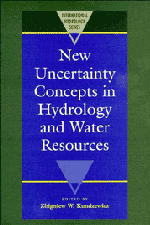Book contents
- Frontmatter
- Contents
- List of Authors
- Preface
- I INTRODUCTION
- II FACETS OF UNCERTAINTY
- 1 Bayesian relative information measure – a tool for analyzing the outputs of general circulation models
- 2 A stochastic weather generator using atmospheric circulation patterns and its use to evaluate climate change effects
- 3 Hydrological uncertainty – floods of Lake Eyre
- 4 Some aspects of hydrological design under non-stationarity
- 5 New plotting position rule for flood records considering historical data and palaeologic information
- III NOVEL APPROACHES TO UNCERTAINTY: FRACTALS, FUZZY SETS AND PATTERN RECOGNITION, NON-PARAMETRIC METHODS
- IV RANDOM FIELDS
- V TIME SERIES AND STOCHASTIC PROCESSES
- VI RISK, RELIABILITY AND RELATED CRITERIA
5 - New plotting position rule for flood records considering historical data and palaeologic information
Published online by Cambridge University Press: 07 May 2010
- Frontmatter
- Contents
- List of Authors
- Preface
- I INTRODUCTION
- II FACETS OF UNCERTAINTY
- 1 Bayesian relative information measure – a tool for analyzing the outputs of general circulation models
- 2 A stochastic weather generator using atmospheric circulation patterns and its use to evaluate climate change effects
- 3 Hydrological uncertainty – floods of Lake Eyre
- 4 Some aspects of hydrological design under non-stationarity
- 5 New plotting position rule for flood records considering historical data and palaeologic information
- III NOVEL APPROACHES TO UNCERTAINTY: FRACTALS, FUZZY SETS AND PATTERN RECOGNITION, NON-PARAMETRIC METHODS
- IV RANDOM FIELDS
- V TIME SERIES AND STOCHASTIC PROCESSES
- VI RISK, RELIABILITY AND RELATED CRITERIA
Summary
ABSTRACT The graphical curve fitting procedure has been favoured by many hydrologists and engineers, and the plotting positions are required both for the display of flood records and for the quantile estimation. The existing plotting position formulae which consider historical floods and palaeologic information are reviewed and discussed. The plotting positions for systematically recorded floods below the threshold of perception must be adjusted to reflect the additional information provided by the pre-gauging period if the historical flood data and the systematic records are to be analyzed jointly in a consistent and statistically efficient manner. However, all available formulae are unlikely to adjust these plotting positions properly. It is felt that the traditional rule and exceedance rule assumptions are inconsistent with the floods over and below the threshold of perception of historical floods. A new type of formula is proposed and examined. Simulation studies and numerical examples show that the new formula type performs better than the traditional rule and competitive to the exceedance rule. The Weibull based formulae result in large bias in quantile estimation. If an unbiased plotting position formula were required, then the proposed modified exceedance Cunnane formula would be the best selection.
INTRODUCTION
Probability plots are much used in hydrology as a diagnostic tool to indicate the degree to which data conform to a specific probability distribution, as a means of identifying outlier, in order to infer quantile values.
- Type
- Chapter
- Information
- Publisher: Cambridge University PressPrint publication year: 1995



